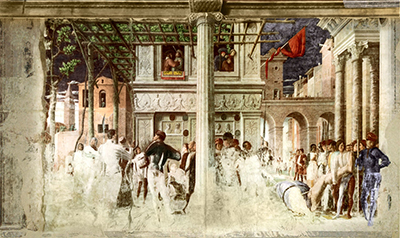The Martyrdom of St Christopher is one of the best art pieces of the Italian Renaissance. As evidenced by the exact proportion of the artist, Mantegna’s work has a rare selection feature of ancient art and culture.
In most times, this includes shortening perspectives and hyperbole. The Italian artists who worked in Padua for a while, Filippo Lippi, Paolo Uccello and, above all, Donatello impacted Mantegna. In this way, Mantegna could see works of master sculptors.
Inspirations of his work on the relief of ancient Rome are the characters and objects compressed in the shallow spaces. Made in Italy in the year 1776, the Martyrdom of St Christopher depicts St James restoring sight to a blind man. They used print on paper to make the magnificent art piece. The painter has improved the accuracy of the appearance and makes the character a privilege. Mantegna’s work is rigorous, showing rather rigorous integrity rather than elegant expression sensitivity. His shawl has been carefully folded and studied from paper-draped models and rubber-cemented fabric.
The artwork of Mantegna is the main expression tool for people. Because, of his deep concern, the diffusion of fundamental human qualities, including intellectuals and emotional audiences counterbalanced the artist's style. Mantegna may have noticed that he can create new, more complex images using a close-up story. It pays particular attention to the lightest folds and folds of linen and often compares them with harder materials. In Italy, there are two methods of sculpture. The refined style associated with the Finiguerra School is characterized by very fine lines, finely cut, sometimes combined with cross-hatching and dots. One common method is low density and uses parallel lines cut across the diagonal to model the shape. In Colouring, the spacing is wider than the fine method, without shadows.
The range of Italian prints is relatively wide. The revival of the Renaissance makes the artist more purely aesthetic, decorative and emotional. In addition to religious themes, Italian prints include myths, simple ornaments and the best old portrait sculptures. Rev. Alexander Dyce bequeathed the Martyrdom of St Christopher and is in the Victoria and Albert museum Prints & Drawings Study Room, level H, case DG, shelf 66.




